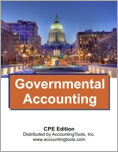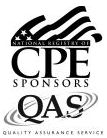Governmental Accounting (CPE Course)
CPE Credit: 13 hours
Course Type: Downloaded PDF materials with online test
Price (with PDF Textbook): $90

Course Description
The accounting used by government entities is substantially different from the accounting used by for-profit organizations. This course describes the unique aspects of governmental accounting, including the use of funds, the modified accrual basis of accounting, and many unique financial statement formats and disclosures. There is a strong emphasis on common accounting transactions, the annual comprehensive financial report, budgetary reporting, and nonexchange transactions. In short, Governmental Accounting
is an essential desk reference for the professional accountant.
Author:Steven Bragg
Course Number: AC1111
Table of Contents
Chapter 1. Governmental Accounting Overview
Chapter 2. Fund Accounting
Chapter 3. Basis of Accounting and Measurement Focus
Chapter 4. Reporting Capital Assets
Chapter 5. Reporting Liabilities
Chapter 6. The Budget and Budgetary Accounting
Chapter 7. Common Accounting Transactions
Chapter 8. Classification and Terminology
Chapter 9. Defining the Financial Reporting Entity
Chapter 10. Comprehensive Annual Financial Report
Chapter 11. Additional Financial Reporting Considerations
Chapter 12. Notes to Financial Statements
Chapter 13. Budgetary Reporting
Chapter 14. Cash Flows Statements
Chapter 15. Segment Information
Chapter 16. Reporting Entity and Component Unit Presentation and Disclosure
Chapter 17. Statistical Section
Chapter 18. Fair Value Measurement
Chapter 19. Claims Accounting
Chapter 20. Landfill Closure and Postclosure Costs
Chapter 21. Leases
Chapter 22. Nonexchange Transactions
Learning Objectives
-
Recognize the entities responsible for formulating accounting standards.
-
Cite the organizational structure used by governmental accounting standards.
-
Specify the different types of funds and how they are used.
-
Describe the accounting structure of a fund.
-
Identify the characteristics of the different bases of accounting.
-
Specify how the accounting treatment for revenue varies, based on when it is received.
-
Recognize the accounting for incurred but unmatured liabilities.
-
Recognize the different types of infrastructure assets.
-
Identify the types of costs that can be included in the cost of a capital asset.
-
Specify when interest costs should and should not be capitalized.
-
Describe the stages of completion associated with the recognition of computer software.
-
Recognize the various indicators of asset impairment.
-
Specify the different types of long-term debt.
-
Recognize the different types of current liabilities.
-
Identify the funds that are more likely to have budgets associated with them.
-
Describe how an encumbrance is used.
-
Cite the different types of interfund activities.
-
Specify the classifications used to track expenditures.
-
Identify the components of net position.
-
Describe the nature of a financial reporting entity.
-
Specify the indicators of control over another entity.
-
Describe the contents of the various components of the comprehensive annual financial report.
-
Describe how the order of liquidity is applied in the statement of net position.
-
Recognize the proper accounting treatment for issued debt.
-
Describe how a negative balance is treated in the restricted net position line item.
-
Identify the different categories used for program revenues.
-
Specify the formula underlying a balance sheet.
-
Specify the disclosures used when there is a related party transaction.
-
Describe the proper accounting for the correction of an error.
-
Define a change in estimate, principle, and entity.
-
Specify the topics that should be covered in the notes to the financial statements.
-
Recognize the circumstances under which an accounting policy should be disclosed.
-
Cite the disclosures needed when future revenues are sold.
-
Identify the circumstances under which a budgetary comparison should be presented.
-
Describe the nature of budgetary control.
-
Recognize the types of funds that must present a statement of cash flows.
-
Specify how a statement of cash flows is constructed.
-
Identify the transactions that are associated with each of the classifications in a statement of cash flows.
-
Recognize the circumstances under which discrete presentation is used in the financial statements.
-
Recognize the factors involved in designating a component unit as major.
-
Cite the circumstances under which a statistical section is included in a set of financial statements.
-
Describe the formulation of fair value for real and personal property.
-
Specify which governments must include overlapping rates information in their financial statements.
-
Recognize the different types of demographic and economic indicators.
-
Specify the types of costs that can be associated with a purchase.
-
Describe the different levels of the fair value hierarchy.
-
Cite the criteria for determining whether risk has been transferred.
-
Specify the accounting to use when a loss has been incurred.
-
Identify the characteristics of a conduit debt obligation.
-
Specify the proper accounting for escheat property.
-
Recognize the types of costs associated with landfill closure and postclosure activities.
-
Specify the proper accounting for a change in the estimated total current cost of landfill closure and postclosure care.
-
Identify the circumstances under which a lease liability should be revised.
-
Describe the components of the lease receivable asset.
-
Specify the circumstances under which a government does not recognize a nonexchange transaction.
-
Cite the different types of restrictions associated with a grant.
-
Specify the accounting for a pass-through grant.
Level: Intermediate
Instructional Method: QAS Self-Study
NASBA Category: Accounting (Governmental)
Prerequisites: None
Advance Preparation: None
Latest Review Date:November 2023
Program Registration Requirements: Click on "Purchase Course" near the top of this page to pay for and access the course. You will then be able to download the course as a PDF file, then take an on-line examination, and then download a certificate of completion if you pass the examination.
Program Refund Policy: For more information regarding administrative policies concerning complaints, refunds, and other matters, see our policies page.

AccountingTools, Inc. is registered with the National Association of State Boards of Accountancy (NASBA) as a sponsor of continuing professional education on the National Registry of CPE Sponsors. State boards of accountancy have the final authority on the acceptance of individual courses for CPE credit. Complaints regarding registered sponsors may be submitted to the National Registry of CPE Sponsors through its website: www.nasbaregistry.org .
The NASBA sponsor identification number for Accountingtools, Inc. is 115881.

AccountingTools is an IRS Approved Continuing Education Provider. We are compliant with the requirements for continuing education providers (as described in sections 10.6 and 10.9 of the Department of Treasury’s Circular No. 230 and in other IRS guidance, forms, and instructions). Our IRS Approved Continuing Education Provider number is 72821.

